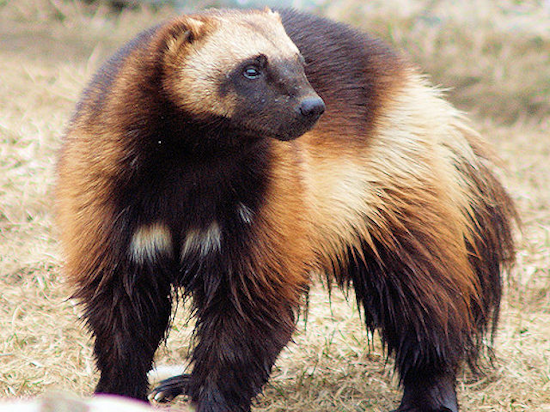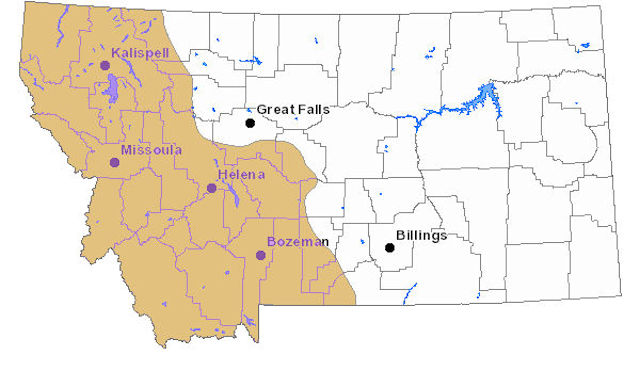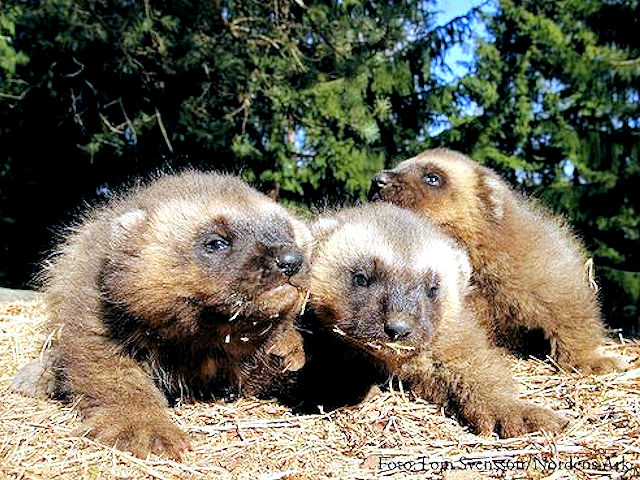Wolverine

Gulo gulo
Order: Carnivora
Family:
Mustelidae
Other Names: Devil bear, carcajou, skunk bear, devil beast.
Status: Wolverine fur is highly valued and widely used in the Arctic and sub-Arctic as ruffs or trim on parkas and other garments. The most viable and widespread population of wolverines in the contiguous 48 states occurs in the Rocky Mountains of Montana. Official Montana furbearer managed and protected by regulated fur harvest seasons.
Identifying Characteristics: Except for its bushy tail, the wolverine looks like a small bear. Compact and strongly built. Medium brown to almost black in color. Color is paler on the head; two broad, yellowish stripes that start at shoulders and join on rump. Often displays white or light tan patch markings on the throat and chest. Feet are large in relation to size of body. Largest terrestrial member of the weasel family.
Total length: 31 to 51 inches. Weight: 35 to 60 pounds.
Habitat: The primary wolverine habitat in Montana is the coniferous forest types of the Rocky Mountains. Roams large areas in solitude. Mainly animals of the heavy forest.
Food Habits: A very opportunistic feeder. Generally a carnivore, will also feed on meat carrion and berries. Famous for robbing traps and food caches of trappers. When necessary, can kill animals many times its own size.
Life History: Active day or nights. Except for the breeding season exhibits solitary habits. General behavior is similar to other mustelid predators. Dens in any sheltered place. Breeds during summer; litters from 1 to 5 young are born between February and April. Exhibits delayed implantation of the fertilized egg.
Similar Species: Fisher - no yellowish body stripes.
 Characteristics
Characteristics
The wolverine is a powerfully built, long haired
animal, somewhat resembling a small short legged
bear, with markings similar of those of a skunk.
The back is arched, and the tail is bushy. The
feet are large and well furred, with long,
non-retractile claws.
Males are 31 to 51 inches long, including a 8 to 9 inch tail. They stand 12 to 14 inches at the shoulder and weigh 35 to 60 pounds. Females are about one quarter smaller.
Because of its size, stocky form, and long coat, the wolverine cannot be easily mistaken for any other mammal.
The head is broad and short snouted with small, rounded ears, small eyes, massive teeth, and powerful jaws. The neck is short and powerfully muscled, as are the shoulders. The senses of smell and hearing are good but sight is poor.
The fur is long, with coarse guard hairs and thick underfur when prime. The color and texture varies with the individual. Usually, they are dark brown above the pale lateral stripes which run from shoulders to rump, merging at the rump and extending along the top of the tail. In some individuals, the contrast is very distinct while in others it is faint.
The under parts are dark, often with irregular white or orange markings at the throat and a bright orange patch on the belly, indicating the location of a gland.
The wolverine walks in a flat footed manner. The hind feet in fact, resemble the feet of a man. It travels in several gaits but a sort of run with long, bounding strides is the most common. It is not a particularly fast runner but can travel tirelessly over long distances.
The wolverine is a courageous animal which is respected and avoided by other predators. Even cougar and grizzly bear have been known to abandon a kill on the approach of a wolverine. Wolverines will often urinate on carcasses, fouling them so that no other animal will eat them.
 Life Cycle
Life Cycle
Both sexes reach sexual
maturity during their second summer. Mating is
said to take place from April to October. A
delayed implantation occurs, with an active
gestation period of 60 days. The young are born
in late March or early April. One to four young
are born in dens located under protective rock
slides, natural caves, under the roots of trees
or windfalls.
The young are covered with fine white hair. The females gives the young extensive care for up to one year, after which she drives them from her territory.
Food
Wolverines mainly eat the flesh of mammals or
birds. Wolverines are generally too large to
subsist well on small game, too small to
effectively kill large game regularly and too
slow to pursue swift animals. As a result, they
often resort to scavenging carrion. Often, they
subsist almost entirely on winter killed animals
or the kills of other predators. This habit also
attracts them to trap areas where trapped or
dead animals are more available. The wolverine
will hunt and kill whenever the opportunity
presents itself and they are tireless and
persistent in their hunting activities. They
will take a wide variety of foods, including
hares, mice, lemmings, ground squirrels,
chipmunks, marmots and beaver. Berries are often
eaten in late fall. When food is scarce, the
wolverine will attempt to kill big game animals
and there are authentic records of attacks upon
mountain goats, moose, deer and elk.
Habits
Little is known about the habits of the
wolverine. Due to its poor eyesight, it has been
noted to come within 50 to 60 yards of man
before becoming alarmed. If not absolutely sure
of what lies ahead, it will sit on its haunches
and shade its eyes with its forepaws, just as a
human would do if scrutinizing a dim or distant
object.
Wolverines avoid water or even heavy rain if possible, but will cross small water obstacles when necessary. Its habits of following trap areas, robbing bait, kill, and eating trapped animals while avoiding capture has caused problems for trappers.
Wolverines are most active at night but will travel in daylight, especially in winter. They are normally solitary and very intolerant of each other except during the breeding season. They have large territories and will periodically travel great distances.
Population
Wolverine are never abundant but are sparsely
scattered over extensive areas. As a result,
they seem to maintain a stable but low
population most of the time. They need
wilderness areas where they can avoid conflicts
with man.
The most viable and widespread population of wolverines in the contiguous 48 states occurs in the Rocky Mountains of Montana.
Habitat
The wolverine is a creature of the northern
wilderness, frequenting heavily wooded, broken,
rugged, and mountainous areas. The primary
wolverine habitat in Montana is the coniferous
forest types of the Rocky Mountains. Wilderness
is an essential habitat component as it requires
large areas to roam over in solitude.
Economic Value
The fur of the wolverine is extremely durable,
but is generally too long and the leather too
heavy to be used for coats. Most are sold for
parka trim because it does not mat and frost up
as much as most furs. The hoar frost can be
easily brushed out of the fur. The fur is highly
valued and widely used in the Arctic and
sub-Arctic as ruffs or trim on parkas and other
garments. Distinctively colored individuals are
in high demand for rugs or for mounting. They
generally command a fairly high price because of
their rarity.
Distribution and
Status
Wolverine occur in the
western third of Montana in the Rocky Mountain
range. They are managed and protected by
regulated fur harvest seasons.
Special Regulations Note
There is no trapping or harvest of wolverine at this time.